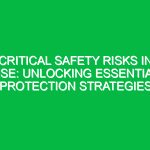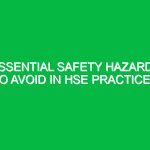Introduction
Hello team, and thank you for gathering for this crucial Toolbox Talk. Today, we’re going to discuss a vital aspect of our health, safety, and environmental (HSE) practices: the concept of Trips in our daily operations. Ensuring that we manage Trips effectively is key to preventing accidents and promoting a safe and efficient work Environment. Our goal is not only to understand the risks associated with Trips but also to implement strategies that will keep us safe while we work. So, let’s dive into this topic and explore how we can make our workplace safer!
Understanding Trips in the HSE Context
When we talk about Trips in the HSE context, we are referring to the potential Hazards that can lead to slips, trips, and falls. These are some of the most common types of workplace accidents, and they can occur in various settings, whether indoors or outdoors. According to Safety statistics, slips, trips, and falls account for a significant percentage of workplace injuries, which can lead to severe consequences. Thus, minimizing these risks is imperative.
The Importance of Addressing Trips
Why should we focus on Trips? The answer is straightforward: safety. Addressing these risks not only protects our health but also enhances productivity. When employees feel safe in their working environment, they can concentrate on their tasks without the distraction of potential Hazards. Additionally, reducing the occurrence of Trips can lead to lower insurance costs and fewer legal liabilities for our organization. In short, every effort we take to prevent these incidents contributes to a safer and more productive workplace.
Identifying Common Causes of Trips
Before we can effectively manage the risk of Trips, it’s important to identify the common causes. Here are a few typical scenarios that can lead to accidents:
- Cluttered Workspaces: Items left on the floor or walkways can create tripping hazards.
- Uneven Surfaces: Cracks in pavement or uneven flooring can easily cause trips.
- Improper Lighting: Poorly lit areas can make it difficult to see potential hazards.
- Wet or Slippery Floors: Spills or weather conditions can create slick surfaces.
- Inadequate Footwear: Wearing inappropriate shoes can increase the risk of slipping or tripping.
Real-Life Example: The Impact of a Trip
Let’s consider a hypothetical scenario: Jane, a team member, was carrying a box of supplies when she tripped over a loose cable on the floor. She fell and injured her wrist, which resulted in her taking time off work for recovery. This incident not only affected Jane but also disrupted the entire team’s productivity. By addressing the trip hazard beforehand — ensuring that cables are secured and pathways are clear — we could have avoided this injury.
Best Practices for Preventing Trips
Now that we’ve identified the common causes of Trips, let’s discuss some Best Practices for preventing these incidents:
1. Keep Work Areas Clean and Organized
Regularly inspect your workspace and ensure that it is free from clutter. Items should be stored properly, and walkways must remain clear. Encourage your coworkers to adopt the same approach by leading by example.
2. Ensure Proper Lighting
Make sure that all working areas, especially staircases and entryways, are well-lit. If you notice a dark area, report it immediately so that appropriate measures can be taken.
3. Use Slip-Resistant Flooring
If possible, utilize slip-resistant mats in areas prone to spills or moisture. This can significantly reduce the likelihood of slipping and tripping.
4. Wear Appropriate Footwear
Choose footwear that provides good grip and support. Encourage your colleagues to be mindful of their shoe choices, especially in areas where slips and trips are more likely to occur.
5. Conduct Regular Safety Inspections
Establish a routine for safety audits in your work area. Identify potential hazards and rectify them before they lead to accidents. Make it a point to discuss findings during our Toolbox Talks to keep everyone informed.
Engaging Employees in Safety Practices
We all share the responsibility of maintaining a safe work environment. Here’s how you can actively engage in safety practices:
1. Report Hazards Immediately
If you see something unsafe, whether it’s a spill or a piece of equipment out of place, report it to your supervisor right away. Prompt reporting allows for swift action to mitigate risks.
2. Participate in Safety Training
Take advantage of any safety training sessions provided by our organization. These sessions are designed to keep you informed about Best Practices and new safety protocols.
3. Share Your Experiences
Encourage open discussions about safety during our toolbox talks. Sharing experiences or near-misses can help others recognize hazards they might not have previously considered.
Regulations and Standards Regarding Trips
It’s essential to understand the regulatory framework surrounding Workplace Safety, especially concerning Trips. Organizations must comply with Occupational Safety and Health Administration (OSHA) regulations, which require employers to provide a safe working environment. Failure to comply can result in penalties and increased liability for the company.
Additionally, our internal safety policies align with osha standards to ensure that we are not only compliant but also committed to providing the safest working conditions possible. Regular training and adherence to safety protocols are instrumental in achieving this goal.
Conclusion
In wrapping up today’s Toolbox Talk, let’s reflect on the key points we discussed regarding Trips:
- Understanding the common causes of Trips is vital in preventing accidents.
- Implementing best practices can significantly reduce the risk of injuries.
- Engaging everyone in Safety Measures fosters a culture of safety and accountability.
- Compliance with Regulations is not just a legal obligation; it’s a commitment to each other’s well-being.
Thank you for your attention and dedication to maintaining a safe work environment. Remember, safety is a shared responsibility, and by working together, we can minimize the risks associated with Trips and ensure a healthier workplace for everyone. I encourage you to discuss any concerns or suggestions you may have, and let’s continue to prioritize safety in all our daily operations.


